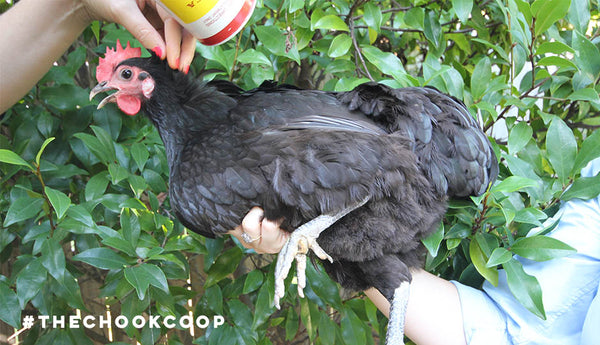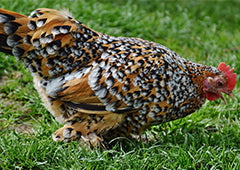Marek’s Disease
It’s important for all poultry keepers to be aware of Marek’s disease, and also whether it’s a problem for other chicken owners in your area.
What is Marek’s Disease?
Marek’s disease is a virus that causes tumours to grow in one or more areas. There are four different strains of Marek’s disease - two strains affect chickens, one doesn’t cause illness, and the last only affects turkeys.
The strains that affect chickens can have the following effects:
- The virus affects the chicken’s central nervous system, causing paralysis in areas such as the legs and wings - also causes the chickens comb to collapse.
- It can also cause tumours in major organs such as the heart, lungs and muscles, and tumours in the follicles of the feathers.
- The other strain of Marek’s that affects chickens can cause blindness in their eyes. This will manifest through turning the chicken’s eyes grey, and causing their pupils to become an irregular shape.
Chickens that have Marek’s disease are also more susceptible to other illnesses. This is because Marek’s damages a chickens immune system - therefore your chickens are more at risk of infections, diarrhoea and other problems.
How is Marek’s disease transmitted?
Marek’s is transmitted by infected ‘poultry dust’ and ‘dander’ being inhaled by the chicken. Poultry dust is a mixture of a few different bits and pieces, such as bird feed, bedding, droppings and old feathers. Dander is a term referring to the dead skin of a chicken.
The problem with dust and dander is that it can float long distances in the air, to be breathed in by a chicken at a new location.
What are the symptoms?
There are a number of different symptoms that indicate a presence of Marek’s disease in the coop. Most are very noticeable, and shouldn’t go easily undetected by a chicken keeper who checks their flock regularly. These include:
- Paralysis in the legs, wings and neck
- A visible loss in weight
- If you look under the feathers, you can see the skin follicles raised with little bumps
- An irregular shaped pupil, or a grey iris
- A collapsed crop
What should I do if I see these symptoms in my flock?
If you notice any of these things in your flock, isolate the bird immediately, and contact your local vet for advice. It may or may not be Marek’s (more on similar diseases later) - but if it is, early detection is very important, as Marek’s is quite contagious.
How do I treat it?
Unfortunately, there is no cure or treatment for chickens that have Marek’s disease.
Some chickens that come into contact with Marek’s disease won’t show any symptoms. In addition, some may show mild symptoms that never progress. Caution should still be taken around these birds, as they are probably now carriers of the disease.
Can I do anything to prevent it?
A vaccination against Marek’s disease is highly effective at keeping this illness at bay - this needs to be done when the chicken is one day old. Because Marek’s is so easily and quickly transmitted, there’s virtually no other way to prevent it other than being vaccinated.
So if you’re buying some chickens or baby chicks, ask them if they’ve been vaccinated against Marek’s disease - that’s really the only protection they’ll have if they come into contact with it.
It is worth noting that the Marek’s vaccination does not 100% protect them from contracting the virus, rather it gives the chickens a boost of resistance against it, reduces the occurrence of the symptoms developing and reduces the amount of virus that is shed in the chicken’s dander.
So...how worried should I be?
Here’s the long and short feather of it. We contacted some local vets and avian doctors to see how many cases of Marek’s they see, and whether it’s common. The truth is, it can be found in rural and urban areas - it’s not egg-stremely common, but they do see some cases from time to time.
Other diseases that LOOK like Marek’s disease, but aren’t.
Sometimes, your chickens can display symptoms that look like Marek’s disease, but is really a precursor for another, less serious problem. So before you diagnose Marek’s and expect the worst, double check it’s not one of these illnesses instead:
- Lice, mites and worms
If chickens have an untreated mites, lice or worms problem, they can display symptoms such as droopiness, discoloured combs and wattles, a decreased appetite and more. For further information on detecting and treating mites and lice, check out this article.
- Egg binding
Egg binding (a disease where the hen is unable to lay her eggs) is a condition that can cause similar symptoms to Marek’s. The main symptom that draws parallels is that the hen won’t be able to use her legs properly, and may squat or be unable to move them. This may seem like paralysis, but it is due to the hen being unable to lay her egg. Other similar symptoms include droopiness.
- Issues with vitamin consumption
If your chickens are deficient in certain vitamins, the effects can look like Marek’s disease. A deficiency in Vitamin B can give your chicken’s paralysis and issues with their legs. Ensure your chickens are getting all the right vitamins through their feed!
Keep calm and keep chickens!
However dire Marek’s may seem, don’t let the disease put you off getting chickens! Many backyard flocks both rural and urban live long, happy lives without ever having to come into contact with this disease. If you’re particularly concerned, make sure you purchase chickens that have already been vaccinated against Marek’s.
As chicken keepers, we like to think that we are doing the best we can for our girls, however, there is often more we can do to prevent health issues. I highly recommend the online chicken keeping course titled Ultimate Chicken Health to all my readers! It is written by our friends over at Chickenpedia. They have compiled everything you need to keep healthy chickens through the seasons (which is more than you think!) with a great set of check-lists and downloads to keep.




















